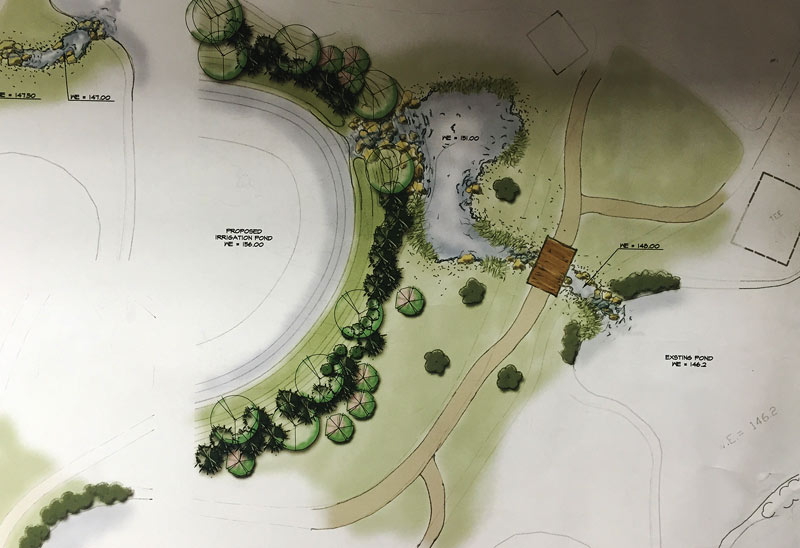
Visual aids: Using charts and graphs to illustrate where your labor and other resources go will make the information clearer and more compelling to the eyes of those calling the financial shots. Photo by Chad McDermott/Shutterstock.com
Throughout my career, I’ve often found myself frustrated by the divide between me and the people making the budget decisions at my club. In 30 years as superintendent at Echo Lake Country Club in Westfield, N.J., I’ve learned some guiding principles and techniques that help me better communicate the green department’s story to sell the club’s decision-makers on the course’s financial needs. I’ve developed these ideas into a course I teach at the Rutgers Professional Golf Turf Management School and as a seminar at the Golf Industry Show. What follows are a few of the most important guidelines I’ve gleaned over the years for effectively proposing budget requests, and they may prove useful to you in preparing your budget and presenting it to those in charge.
1. You are not talking to your peers
Unless you work for a management company with an experienced superintendent in a position above you, or you have a general manager who moved up from the golf course, your bosses most likely don’t understand what golf course superintendents do or why they do it. Conveying your arguments in your bosses’ context — not ours — is the first step toward getting to “Yes.”
Start by establishing a shared understanding of how you want to present the golf course. Discuss with your bosses how greens should play or bunkers should be prepared, for example. This will open the flow of information between you, allowing you to get a sense of their desires and begin educating them on what’s necessary to achieve those results.
An effective way to get everyone on the same page regarding members’ and management’s expectations and the needs of the golf course is to develop a course standards manual. The exercise of creating the manual — discussing your bosses’ goals and your assessment of what’s possible with current resources — will lead to more meaningful budget and planning deliberations. Putting together such a document will also give you the opportunity to explain some of the variables that can significantly affect course maintenance, such as weather, and the manual can be a resource for later budget conversations.
Similarly, many courses have a mission statement that defines their operation’s primary objective. The mission statement of Pebble Beach Resorts puts forth a clear goal: “To exceed the expectations of every guest by providing a once-in-a-lifetime experience, every time.” This directive guides those who manage the world-class facility, but it’s also worthwhile out in the trenches. If the crew has in mind that the aim is to guarantee a memorable experience for every guest, they may carry out their tasks more thoroughly. You don’t have to be a top-100 facility to have a mission statement; any course can find focus by clarifying its main goal in this manner.
2. Bring the problem to them
We are on our courses for thousands of hours every season, so any deficiencies are so embedded in our minds that we can forget that our decision-makers see the course through much different eyes. Photos and other means of “show and tell” are easy ways to relay information, particularly to those who view the course through the lens of a golfer, not a superintendent.
Your bosses have likely never looked below the surface of your greens, for example, and have no concept of what goes on there. Presenting a core sample from a green that’s troubled by layers or too much thatch is a tangible way to alert them to such problems. To shed light on equipment concerns, share photos of deteriorating devices or crowded conditions in the maintenance facility, or bring them an actual corroded swing joint or clogged irrigation nozzle.
3. Bring them to the problem
If you want to upgrade your equipment or maintenance shop, perhaps the best way to gain support is to take your bosses on a tour of your current facilities. If they see the equipment you have now and can appreciate that you’re getting the most out of their previous investments, they may be more inclined to approve your requests. Think of it this way: You could certainly try to describe how a greens mower works or the function of a $40,000 spin grinder, but if your audience actually sees a mower on a lift and can comprehend the precision required to adjust this machine, they’ll have a deeper awareness of what it takes to cut greens at a low height.

Bringing decision-makers onto the course to see turf matters for themselves — such as the difference between treated and untreated areas — will have a far greater impact. Photo courtesy of Chris Carson
I’ve used this technique in other areas too. In 2008, we put in a new irrigation system, and members expected that the rough would improve immediately. That wasn’t the case, however. We’d never had irrigation capabilities in these areas before, so we had a wretched mix of grass species that would die off from disease and stress. By taking the committee on a tour of the course, I was able to show them exactly where the problems were, where fungicide protection was having a positive effect, and where areas sodded with better turf species were withstanding summer stresses with no controls at all. I reinforced these points with photos. Since then, we’ve received more resources to improve our rough.
4. The budget process is year-round
Dismiss the notion that the budget process is a once-a-year-only effort. Take every opportunity to keep your committee informed about issues as they arise, to look down the road for what you’ll eventually need, and to lay the foundation for those requests. Asking for support for a new irrigation system out of the blue won’t make sense, nor will it likely result in the outcome you’re hoping for. If you’ve “prepared the ground” with years of updates on the problems you’ve faced, have done preparatory studies on needs and costs, and have in effect pre-sold your bosses on the idea, they won’t be taken aback when you ultimately make your appeal. In short: Avoid surprises.
This holds true for the overall maintenance of the course as well. If you encounter a new disease or insect problem or are dealing with weather conditions so extreme you’re forced to make an unexpected application or use unbudgeted labor, it’s your responsibility to keep your boss in the loop. Don’t let your chairman or manager go into a meeting with club ownership unprepared to answer why a budget item is off expectations. Anticipate such questions and keep your boss up to date by providing a monthly budget variance report. By addressing questions before your boss even has to ask them, you’ll be seen as a pro who’s on top of your game and who’s looking out for your boss.
5. Humanize your budget
Most superintendents pride themselves on keeping the maintenance crew as invisible as possible, and although this is an admirable goal, it also hurts us. Because we’re out of sight, convincing a budget committee that our staff is important and that suitable salaries and pay increases are appropriate becomes more difficult.
Here at Echo Lake, half the rounds are played with caddies. These are typically high school or college students, and they’re engaged with players for more than four hours. As independent contractors, the caddies are paid directly by the golfer for their efforts to make the game more enjoyable, and they are paid generously. I’m certain the reason for this generosity (which usually comes to three to five times the hourly rate of my staff) is that members feel a personal connection with and responsibility to these individuals, and are thus willing to compensate them well. Yet these same members hesitate if asked to adjust pay rates for grounds crew members. Even a small percentage raise can be seen as an extravagance.

Designed in 1911 by Donald Ross and improved during the “Golden Age” of golf course architecture by Willard Wilkinson, A.W. Tillinghast and Robert White, Echo Lake Country Club spans 141 acres and consists of bentgrass fairways and bent/Poa greens. GCSAA Class A superintendent Chris Carson has overseen maintenance of the course since 1986. Photo courtesy of Chris Carson
Other club employees have similar relationships with members — connections that benefit them when budget discussions come around. When a server in the clubhouse ensures an order is correct, there is an understanding that the server is working hard. But if the maintenance crew does its job well and ahead of play, golfers may just assume the course was prepared by pixies in the middle of the night.
It’s the superintendent’s job, therefore, to give life to our staff — to make sure our team isn’t viewed as just a payroll number, but as a living, breathing asset to the club. You can remind decision-makers that they have this dedicated crew working hard for them by highlighting your team’s efforts, referencing each of them by name and years with the company, praising them by name when they’ve performed well, and perhaps including a photo and description of your team’s accomplishments on the club bulletin board or in its newsletter. It’s much more difficult for those passing judgment on the budget to cut a person and the work he or she does than it is to cut a percentage from a budget line that’s presented as a lump sum.
6. Use comparables
When labor unions negotiate salaries and benefits, the process involves examining what others in similar positions earn. Such comparables are helpful in forming a basis for discussion and getting all parties on the same page. This strategy is valuable for us as well. If we can support a request for an assistant’s salary with industry averages for that position, we lend credibility to our appeal.
You can gather this information from a variety of sources, including GCSAA’s Compensation and Benefits Report. Local chapters frequently offer these figures, and you can also get specifics simply by asking other superintendents in your area. Knowledge of how many staff members local courses employ and how much they’re paid will help you accurately talk about the labor market and back up your budget requests. Looking at cost-per-hole data of courses in your area (your accounting firm can provide this) and pay scales of local businesses may supply you with additional useful insight.
Knowing the average life span of maintenance equipment will give you a leg up when the time comes to replace or upgrade your fleet, and this is especially true if you have a solid record of obtaining full value from equipment purchased in the past. If you can say that, compared with the industry average, you’ve gotten 250 percent of the life expected from your 20-year-old sprayer, you exhibit that you’ve taken care of this investment, received full value from it, and will take the same care of a replacement.
If you want to upgrade your existing equipment to take advantage of new technology, you should once again express your point in a context your bosses can relate to. They may not know much about the differences between old and new aerification technology, but they will understand the difference between older televisions and high-definition televisions. Illustrating your request using something like TV or cell phones will convey the concept of the value of new technology in a way they can grasp and may very well support.
7. Present visually
Like many clubs, Echo Lake downsized its operation when the recession hit in 2008. Among the many changes were reductions in our operating expenses and manpower. The adjustments were appropriate and timely, and they helped the club weather the storm. After a year or two, however, as we climbed out of the hole, I found it tough to get my committee to restore our staff. There was a general misunderstanding among decision-makers about how many people were required to run the caliber of operation they wanted.
My breakthrough moment came when I developed several charts and graphs that revealed the difference in labor use between pre-recession 2008 and post-recession 2011. The visual aids displayed the variance between the two years on a week-by-week basis, and also showed where our manpower had been allocated. My committee was surprised to learn that we’d spent almost twice as much labor on our bunkers as on our greens, and this led to a valuable discussion about where our resources could be best directed. You may benefit in a similar way by visually presenting where your labor has been assigned and where additional crew members would help.

Hue help: The addition of color can bring overhead plans and perspective drawings to life, clarifying them for those who may otherwise find such proposals difficult to visualize. Photo courtesy of Chris Carson
Another step forward occurred when, after years of rejection, the club approved my request to restore a second assistant position, and I have the club’s golf professional to thank for it. At a managers’ meeting, he’d asked me a simple question: “Have you considered taking a different approach by asking to replace the tasks that aren’t being done well or thoroughly?”
I was taken aback by this comment, as it exposed the actual problem: My club didn’t understand what my assistants did or how vital they were to our operation. Assistant superintendents at Echo Lake are hands-on employees, responsible for managing the spray and fertilizer programs, the irrigation system, and daily course setup, as well as supervising the staff. After I showed my bosses a monthly breakdown of my assistant’s tasks and responsibilities, they quickly agreed there was a need for a hire, and the subsequent elevated quality of our work was visible to and appreciated by members.
8. Remember: You are selling
I try my best to ensure my budget document and the plan it contains are clear and straightforward. A common flaw I notice in students’ work at Rutgers is the use of jargon in their budget plans. They may think tossing in Latin binomials and esoteric chemical names makes them appear professional, but I think people unfamiliar with our profession can get tripped up by these attempts, and we lose credibility. Instead of, “We plan to control outbreaks of Rhizoctonia solani with pyraclostrobin,” you can simply say, “We plan to control brown patch disease with chemicals.” Attach a photo of the disease, and you’ve just made your point far easier to understand.
Another example: In working with drawings of course features in plan form, what seemed rudimentary to me always seemed confusing to my bosses. When I had plans for our new irrigation ponds colored in to designate fairways, rough and water, it boosted their understanding. Adding color to perspective drawings helped my committees visualize those proposals too. The extra steps were worth the effort, and they allowed me to live up to an important business maxim: Make it easy for your customer to buy your product.
Chris Carson is the GCSAA Class A superintendent at Echo Lake Country Club in Westfield, N.J., where he has worked for 30 years. He teaches courses on budgeting and professional development at the Rutgers Professional Golf Turf Management School. A 31-year member of GCSAA, Chris has served as president of both the GCSA of New Jersey and the New Jersey Turfgrass Association.